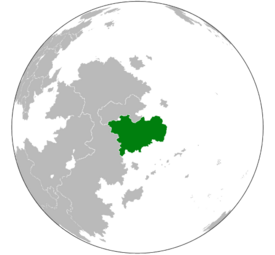Umoja
United Mujic Republic (UMR) | |
|---|---|
|
Flag | |
| Motto: Maelewano Hupatikana Katika Ibila Harmony is found in Ibila | |
| Anthem: Wimbo wa Umoja (Song of Unity) | |
 | |
| Capital | Kompashu |
| Largest city | Mutwe |
| Official languages | none |
| Recognised national languages | Kiwanji, Kinqa, Tsatorasy, Intwile |
| Recognised regional languages | Gaullican, Dietsmenic, Estmerish |
| Liturgical Language | Kiwanji |
| Ethnic groups | West Wanji, East Wanji, Tsitori, Nqa, Dietsmen, Intwile, Varimi |
| Demonym(s) | Umojan |
| Government | Theocratic State |
• Mzee Kubwa/Great Elder | Khalfani Tiso |
• Prime Minister | Ikina Fatah |
| Legislature | Mujic Assembly |
| Mkutano wa Ibila | |
| Bazara | |
| Unification | |
• West Ardam Invasion | 1950s |
• Treaty of Shawari, Kiara joins | 1963 |
| Population | |
• Estimate | 55m |
• Density | 28/km2 (72.5/sq mi) |
| HDI (2014) | 0.789 high |
The United Mujic Republics is a theocratic union of 55 million inhabitants in Bahia. The union is comprised of three countries, Ardam Nzuri, Ardam wa Pwani and Nqaya. The nation is therefore commonly known as Umoja, meaning Unity. The states correspond with the major concentrated ethnic groups of Umoja, each retaining a unique local language and traditions while being connected through the liturgical Kiwanji language and Mujua religion.
The region that is Umoja today was first inhabited by diverse groups of paleo-hunter gatherer people that spanned the Ardamian Plateau. Migration from the south introduced the Tsatori people who settled along the coast by 1,000 BCE, then in 300 BCE the proto-Nqaya had arrived from inland. By 400 AD the Wanji invasion occurred, they conquered the Nqaya and tribes of the region to establish the Mussai-Ardami Empire in the name of their prophetic shaman king. The Wanji had brought Mujua religion and settled as the dominant sedentary culture in the area, solidifying Mujua as it evolved into an organized complex of philosophy and religion. Throughout the middle-ages various Wanji-based kingdoms waged war and political intrigue against eachother in the wake of Imperial collapse, while Tsitori city-states mediated coastal trade. The Ardami Empire would go through varying periods of civil war and unification,
Contact with Eucleans first occurred in the 14th century, as declining Tsitori city-states came under increasing influence. The next few centuries would see the Tsitori cities annexed by the Ardam Empire and dominionized by Gaullica. More of the Ardam-Tsitori coast would be pushed under colonial rule by the 19th century and a series of wars would lead to the subjugation of the inland Ardam Empire. Kiara, taken as a refuge state by natives, was also soon conquered by Estmere. During years of colonial rule, known as ‘the Era of Occupation’ in Umoja, the territory would be rife with conflict and resistance. This tension would culminate in varying widespread atrocities and growing rebellion, as Gaullica, Estmere and eventually Werania, would struggle to retain law and order. Dissatisfied with the treatment they received after they had fought in the Great War, Ardami Askari Troops openly rebelled and launched a decade long insurgency, securing the borders of landlocked West Ardam. In 1950, East Ardam would be granted independence, but would soon be annexed in a Holy War by the west. Nqaya would join shortly after in Mujua unity.
The theocratic state is centrally ruled by the Mzee Kubwa, Great Elder, who’s goal is to enforce Mujic law across the government and country. The Mzee Kubwa is elected from the Mkutano wa Ibila(The Meeting of Ibila), an assembly of prominent elder religious leaders. The Prime Minister is elected through the legislative Baraza, at the anointing approval of the Mzee Kubwa.
